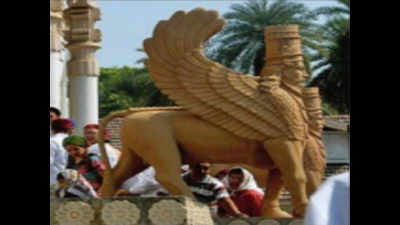- News
- City News
- surat News
- Navsari Parsis can now choose burial after death
Trending
This story is from January 9, 2017
Navsari Parsis can now choose burial after death
Parsis in Navsari can choose burial after death instead of traditional practice of ‘dokhmenishini’ to dispose of a body of their kin. Navsari is the city with highest population of the community in Gujarat. The traditional practice for disposal of a body will also continue at two Dokhmas.

Parsis in Navsari can choose burial after death instead of traditional practice of ‘dokhmenishini’ to dispose of a body of their kin. Navsari is the city with highest population of the community in Gujarat. The traditional practice for disposal of a body will also continue at two Dokhmas.
Key Highlights
- Parsis in Navsari can choose burial after death instead of traditional practice of ‘dokhmenishini’ to dispose of a body of their kin.
- Navsari is the city with highest population of the community in Gujarat.
- The traditional practice for disposal of a body will also continue at two Dokhmas.
SURAT: From now on Parsis in Navsari, the city with highest population of the community in Gujarat, can choose burial after death instead of traditional practice of ‘dokhmenishini’ to dispose of a body of their kin. The traditional practice for disposal of a body will also continue at two Dokhmas in Dungarwadi of Viraval in Navsari. Aramgah, the burial ground, will be developed around the Dokhmas, community leaders said.
Majority of community members supported the decision at a meeting held at Khurshed Wadi close to Dungarwadi on Sunday.The meeting was convened by Navsari Samast Parsi Zoroastrian Anjuman (NSPZA) after 163 community members demanded starting of burial practice. They had sent a letter to NSPZA six months ago after which a general meeting of the organization was convened.
“Little over 2,000 Parsis live in Navsari, which is highest number in Gujarat. A large number of Parsis also live in neighbouring villages. The decision will help Parsis find a suitable place for dead kin near their houses and would no more need to come all the way to Navsari for dokhmenishini,” said Jimmy Bacha, in-charge president, NSPZA.
“Out of the total 166 members present at the meeting, seven opposed the decision. We have to change with time for betterment of community,” Bacha added.
“Earlier a body was kept at Dokha for vultures to eat it. In the absence of vultures, we were disposing of the bodies using solar energy and heat. It takes a lot of time to dispose of a body and hence community members wanted us to adopt burial as another mode,” said Kersi Deboo, a committee member of NSPZA.
Top community leaders and priests had objected to the agenda of the meeting of NSPZA and wanted the traditional practice for disposal of the body to be continued. However, NSPZA took the decision not taking into consideration the objections.
Majority of community members supported the decision at a meeting held at Khurshed Wadi close to Dungarwadi on Sunday.The meeting was convened by Navsari Samast Parsi Zoroastrian Anjuman (NSPZA) after 163 community members demanded starting of burial practice. They had sent a letter to NSPZA six months ago after which a general meeting of the organization was convened.
“Little over 2,000 Parsis live in Navsari, which is highest number in Gujarat. A large number of Parsis also live in neighbouring villages. The decision will help Parsis find a suitable place for dead kin near their houses and would no more need to come all the way to Navsari for dokhmenishini,” said Jimmy Bacha, in-charge president, NSPZA.
“Out of the total 166 members present at the meeting, seven opposed the decision. We have to change with time for betterment of community,” Bacha added.
“We have both options. Community members are free to follow the traditional way and those who want burial are free to adopt it. We have completed the procedure peacefully and the majority has supported the decision,” said Yezdi Kasad, secretary, NSPZA.
“Earlier a body was kept at Dokha for vultures to eat it. In the absence of vultures, we were disposing of the bodies using solar energy and heat. It takes a lot of time to dispose of a body and hence community members wanted us to adopt burial as another mode,” said Kersi Deboo, a committee member of NSPZA.
Top community leaders and priests had objected to the agenda of the meeting of NSPZA and wanted the traditional practice for disposal of the body to be continued. However, NSPZA took the decision not taking into consideration the objections.
End of Article
FOLLOW US ON SOCIAL MEDIA











